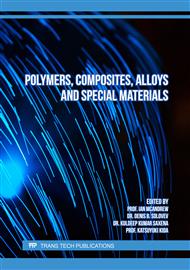p.3
p.9
p.17
p.23
p.29
p.35
p.43
p.55
ABS/AgZrP Nanocomposite Additive Manufacturing Filament for Antibacterial Applications
Abstract:
The emergence of COVID-19 raised awareness in hygiene practices and reminded us of the harm that microbes bring to our health. Incorporating antibacterial agents in polymeric materials would allow us to combat lingering bacteria on surfaces that we often use. The utilization of composite filaments with antibacterial activity would allow us to employ better precautions in reducing contact with harmful bacteria. Antibacterial acrylonitrile‐butadiene‐styrene (ABS) nanocomposites were prepared by incorporating silver zirconium phosphate (AgZrP) nanoparticles via twin screw extruder. The ABS/AgZrP nanocomposite filament with 5 wt % and 20 wt% of AgZrP were synthesized and characterized with Differential scanning calorimetry (DSC), Thermogravimetric Analysis (TGA), X-ray diffraction analysis (XRD), and Fourier transform infrared spectroscopy (FTIR). DSC and XRD data denote an increase in the presence of crystalline regions as the AgZrP content is increased. TGA data indicate that the addition of AgZrP has no effect on the thermal stability of the material. FTIR data indicate a decrease in transmission at higher AgZrP loading. The decreasing trend in tensile properties of the 3D-printed neat and AgZrP-filled ABS may have been due to particle agglomeration acting as stress concentrators. Antibacterial activity assessment via disk diffusion test showed a zone of inhibition within the sample indicating that there is no bacterial growth both for Escherichia coli and Staphylococcus aureus.
Info:
Periodical:
Pages:
3-8
Citation:
Online since:
April 2023
Price:
Сopyright:
© 2023 Trans Tech Publications Ltd. All Rights Reserved
Share:
Citation:



